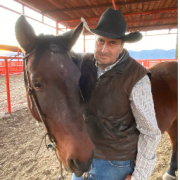Responding to water shortages and uncertainties throughout the western United States, the National Center for Appropriate Technology (NCAT) has released a new edition of its popular The Irrigator’s Pocket Guide.
“With growing conflict over water supplies, and with irrigators feeling the pinch to save water, energy, and money, we wanted to come up with a concise and super-useful guide to water and energy conservation,” said Mike Morris, NCAT’s Southwest Regional Director, who headed up the project.
Irrigation experts from more than 20 states have weighed in on The Irrigator’s Pocket Guide over the years, and more than 30,000 copies have been distributed.
This new edition was developed through NCAT’s Soil for Water project, with funding from USDA’s Natural Resources Conservation Service (NRCS).
“In this new edition of The Irrigator’s Pocket Guide, we decided to go beyond pump and motor maintenance and irrigation scheduling and incorporate recent advances in soil science,” Morris said. “When soil gets healthier, it catches and holds more water. Taking care of soil health therefore needs to be a priority for all irrigators.”
The Equipment Maintenance half of the book features clear and detailed maintenance and troubleshooting procedures for pumps, motors, engines, control panels, and distribution systems. The Water Maintenance section of the book covers soil health and gives step-by-step instructions for running all common types of irrigation systems efficiently — matching water applied to crop needs.
The compact 150-page book includes dozens of diagrams, tables, and handy conversions and formulas for calculating things like flow rates, area, pressure, power, friction losses, and how long to run a system to apply a given volume of water. With its small 4-inch by 6-inch size and durable waterproof covers, the book is a friendly companion to carry in your hip pocket or the glove box of your truck.
Free copies are available by mail or online at the ATTRA website.
Along with the updated edition of the original The Irrigator’s Pocket Guide, new state-specific editions are also available for irrigators in Colorado, New Mexico, and Texas, as well as an updated version of the popular The California Microirrigation Pocket Guide. All these books can be found on the ATTRA website.

 Nina Prater has been with the National Center for Appropriate Technology (NCAT) since 2016 as a Soil Specialist and Outreach Coordinator in the Southeast Regional Office. She strives to help farmers understand soils as a living entity so that they are able to farm profitably and build healthy soils for long-term success. Nina also works closely with the Gulf States Regional Office staff to coordinate outreach efforts in that region. Nina served as an Energy Corps member in 2013 and worked for her local conservation district for 2.5 years before joining NCAT. Nina and her husband Jeremy own and operate a small sustainable livestock operation in the Ozarks hills of Arkansas, where they raise meat goats, cattle, hogs, and poultry. They utilize adaptive grazing methods to build soil health in their pastures.
Nina Prater has been with the National Center for Appropriate Technology (NCAT) since 2016 as a Soil Specialist and Outreach Coordinator in the Southeast Regional Office. She strives to help farmers understand soils as a living entity so that they are able to farm profitably and build healthy soils for long-term success. Nina also works closely with the Gulf States Regional Office staff to coordinate outreach efforts in that region. Nina served as an Energy Corps member in 2013 and worked for her local conservation district for 2.5 years before joining NCAT. Nina and her husband Jeremy own and operate a small sustainable livestock operation in the Ozarks hills of Arkansas, where they raise meat goats, cattle, hogs, and poultry. They utilize adaptive grazing methods to build soil health in their pastures. Lee Rinehart is a graduate of Texas A&M University, where he studied animal science and agricultural education. He currently works as an agriculture specialist in the National Center for Appropriate Technology’s Northeast Regional Office, where he focuses on pasture and rangeland ecology and grazing systems. He has served as county Extension agent in Texas and Montana, organic farm educator in Pennsylvania, and cattle ranch manager in central Texas. His specialty is developing grazing plans and assisting producers in using animals to renovate pastureland. Lee is a Chief Petty Officer in the Navy Reserve and spends his free time biking, sailing, and renovating his 1925 Cape Cod house in Northeast Pennsylvania.
Lee Rinehart is a graduate of Texas A&M University, where he studied animal science and agricultural education. He currently works as an agriculture specialist in the National Center for Appropriate Technology’s Northeast Regional Office, where he focuses on pasture and rangeland ecology and grazing systems. He has served as county Extension agent in Texas and Montana, organic farm educator in Pennsylvania, and cattle ranch manager in central Texas. His specialty is developing grazing plans and assisting producers in using animals to renovate pastureland. Lee is a Chief Petty Officer in the Navy Reserve and spends his free time biking, sailing, and renovating his 1925 Cape Cod house in Northeast Pennsylvania. David R. Montgomery, University of Washington and Dig2Grow.com
David R. Montgomery, University of Washington and Dig2Grow.com Alejandro Raul Carrillo, Las Damas Cattle Ranch
Alejandro Raul Carrillo, Las Damas Cattle Ranch